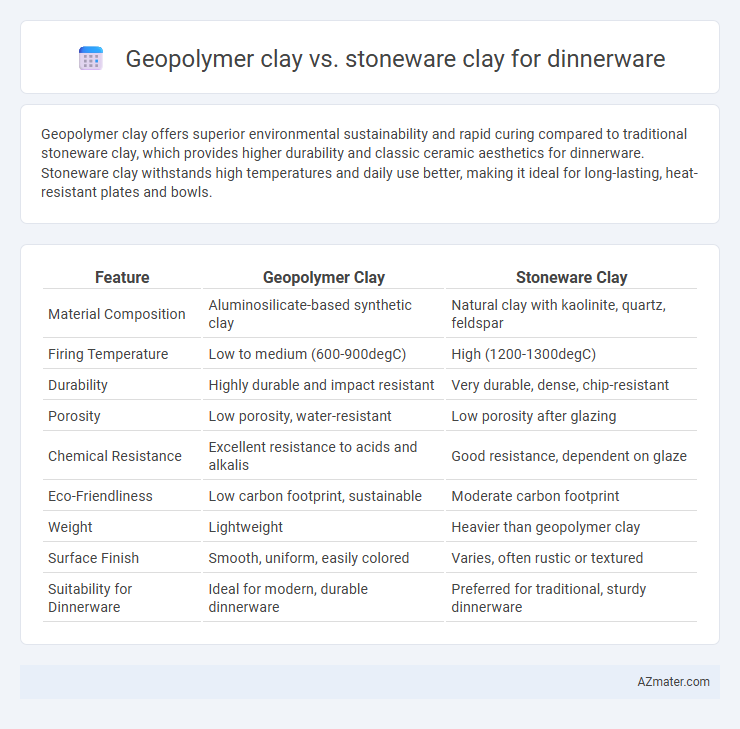Geopolymer clay offers superior environmental sustainability and rapid curing compared to traditional stoneware clay, which provides higher durability and classic ceramic aesthetics for dinnerware. Stoneware clay withstands high temperatures and daily use better, making it ideal for long-lasting, heat-resistant plates and bowls.
Table of Comparison
| Feature | Geopolymer Clay | Stoneware Clay |
|---|---|---|
| Material Composition | Aluminosilicate-based synthetic clay | Natural clay with kaolinite, quartz, feldspar |
| Firing Temperature | Low to medium (600-900degC) | High (1200-1300degC) |
| Durability | Highly durable and impact resistant | Very durable, dense, chip-resistant |
| Porosity | Low porosity, water-resistant | Low porosity after glazing |
| Chemical Resistance | Excellent resistance to acids and alkalis | Good resistance, dependent on glaze |
| Eco-Friendliness | Low carbon footprint, sustainable | Moderate carbon footprint |
| Weight | Lightweight | Heavier than geopolymer clay |
| Surface Finish | Smooth, uniform, easily colored | Varies, often rustic or textured |
| Suitability for Dinnerware | Ideal for modern, durable dinnerware | Preferred for traditional, sturdy dinnerware |
Introduction to Geopolymer and Stoneware Clays
Geopolymer clay, made from aluminosilicate materials activated by alkaline solutions, offers high durability and chemical resistance, making it a modern alternative for dinnerware. Stoneware clay, a traditional ceramic material, is vitrified at high temperatures, resulting in a dense, non-porous surface ideal for everyday use. Both clays provide strong, heat-resistant properties but differ significantly in composition and environmental impact.
Composition and Raw Materials
Geopolymer clay for dinnerware consists primarily of aluminosilicate minerals such as metakaolin combined with alkali activators like sodium silicate, creating a synthetic, low-temperature vitrified material. Stoneware clay is a natural blend of kaolin, ball clay, feldspar, and silica, fired at high temperatures between 1200degC and 1300degC to produce a dense, durable ceramic. The chemically engineered geopolymer clay offers enhanced thermal shock resistance and rapid curing, while stoneware clay relies on its natural mineral composition for strength and translucency.
Environmental Impact and Sustainability
Geopolymer clay significantly reduces carbon emissions by utilizing industrial byproducts like fly ash and slag, making it an eco-friendly alternative to traditional stoneware clay, which requires higher firing temperatures and consumes more energy. Stoneware clay, while durable and widely used in dinnerware, contributes to greater environmental degradation through mining and high kiln energy use. Geopolymer clay's low thermal processing and waste repurposing enhance sustainability, promoting a circular economy in ceramic production.
Firing Temperatures and Methods
Geopolymer clay for dinnerware typically cures at low temperatures around 80-100degC through chemical hardening, avoiding traditional kiln firing. Stoneware clay requires high-temperature firing between 1200-1300degC in a kiln to achieve vitrification, which ensures durability and water resistance. The low thermal demand of geopolymer clay offers energy-efficient production, while stoneware's high firing temperature results in a dense, non-porous surface ideal for functional dinnerware.
Strength and Durability
Geopolymer clay exhibits exceptional strength and durability for dinnerware due to its inorganic polymer matrix, providing resistance to cracking and chipping under thermal stress. Stoneware clay is renowned for its dense, vitrified body after firing, offering excellent mechanical strength and longevity in everyday use. Compared to stoneware, geopolymer clay often demonstrates superior impact resistance and chemical stability, making it a robust choice for resilient dinnerware applications.
Food Safety and Chemical Stability
Geopolymer clay offers superior chemical stability and is inherently non-toxic, making it an excellent choice for food-safe dinnerware due to its resistance to leaching harmful substances. Stoneware clay, while durable and widely used in dinnerware, can sometimes contain trace amounts of heavy metals or require glazes that may pose food safety risks if not properly formulated and fired. The highly inert nature of geopolymer clay ensures minimal interaction with food, providing a safer alternative for long-term use in kitchenware.
Aesthetic Qualities and Finish
Geopolymer clay offers a smooth, matte finish with customizable color options that maintain a modern, minimalist aesthetic ideal for contemporary dinnerware. Stoneware clay provides a natural, earthy texture with rich, varied glazes that create a traditional and rustic visual appeal. Both materials ensure durability, but stoneware typically exhibits a more tactile surface, while geopolymer clay allows for sleek, uniform finishes.
Cost and Accessibility
Geopolymer clay offers a cost-effective alternative to traditional stoneware clay, with lower raw material expenses and reduced firing energy requirements, making it accessible for small-scale producers and eco-conscious manufacturers. Stoneware clay, while generally more expensive due to its natural sourcing and higher firing temperatures, is widely available and preferred for its durability and established market presence in dinnerware production. The balance between initial material cost and long-term accessibility depends on production scale and desired product characteristics.
Suitability for Home and Professional Use
Geopolymer clay offers superior durability and heat resistance, making it highly suitable for both home and professional dinnerware applications where long-lasting performance is critical. Stoneware clay is prized for its natural aesthetic and versatility, providing excellent strength and food safety standards ideal for everyday home use and artisanal professional settings. While geopolymer clay excels in industrial settings requiring high temperature endurance, stoneware remains the preferred choice for traditional and handcrafted dinnerware due to its ease of shaping and glazing.
Choosing the Best Clay for Dinnerware
Geopolymer clay offers superior heat resistance and eco-friendly properties, making it ideal for sustainable dinnerware. Stoneware clay provides durability and a naturally dense structure, ensuring long-lasting, chip-resistant dishes. Choosing the best clay depends on desired thermal performance and environmental impact, with geopolymer excelling in sustainability and stoneware favored for traditional strength.

Infographic: Geopolymer clay vs Stoneware clay for Dinnerware
 azmater.com
azmater.com